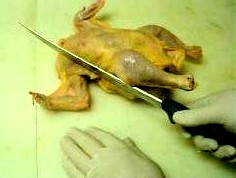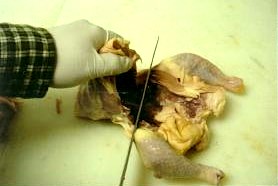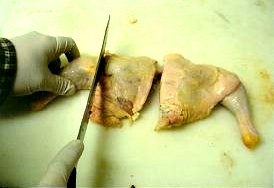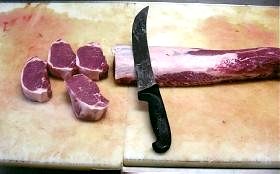As much as I would love to be a complete homesteader, it is just not possible right now. Sure, I do as much as I can so I do not have to rely on “the man,” but there are things I still have to do.
I still must have some type of job, and I still must rely on the grocery store for some of my food. While I do plant a big garden (for food and profit) I must head to the store to buy my meat products. Luckily for me, I was a meat cutter for a number of years so I know how to save at the market. And you can do the same. Just remember a few tips and techniques and you too can become your own butcher – and save big bucks at your local market.
Before we get into home butchering class, let’s go over a few things you might want to invest in. First and foremost, you will need a good, sharp knife. You can use a fish filleting knife if you like – just don’t clean fish with it. You can find good knives and meat cutting kits at Lehmans.com. In fact, you can just about find all your home processing equipment here. This would include a home sealing kit. Otherwise known as a cryovac machine in the meat business, this contraption sucks air out of your package as it seals, giving it a long shelf life.
Another piece of equipment that will come in handy is a hand meat tenderizer. This little device is used to tenderize meat. When you strike your meat item, several retractable blades come out and pierce the meat. This pulls fibers apart, thus tenderizing the meat. And if you want to be “official,” purchase yourself a nice white apron. You are now ready to be a home butcher. But before we go over some techniques, here are a few quick tips:
- Buy In Bulk. This applies to most of your bone-in meat items, hamburger, and smoked products. Since it will be difficult to saw up bone-in meat items, it is best to purchase in family packs. A family pack for example might consist of a package that is five pounds or more, or a package of ten pork chops or more. You can purchase the meat and then take it home to package and wrap it according to your family’s needs. For example, in my area you can save over 40 cents a pound by buying hamburger in ten pound bags. Also, a package of three pork chops might cost $3.69 while a package of ten will cost $3.29/lb.
- Hams – Always buy hams whole. And buy bone-in. Cook and then plan meals around a whole ham. Savings: BIG! Let’s say a bone-in ham averages $1.89/lb. A boneless ham will be twice that, and a simple bone-in ham slice will be three times that. Ham dinners, ham and bean soup, ham sandwiches, casseroles and whatever else you like can be made from one big ham. Wrap and freeze leftovers for other meals. Keep in mind though that ham should not be left in freezer for long periods. Despite being cooked and frozen, it can still spoil while in the freezer. Eat ham within three months.
- Turkey – The best meat buy for your money: TURKEY! This meat item has so much going for it that if you could eat it every day you just might get rich. If you can afford it and have the freezer space, it is best to buy whole when you can, especially right around Thanksgiving. Grocery stores want your holiday business so badly that they will practically give away turkeys at this time. Most stores make very little money on the turkeys themselves; they make the money on your other purchases. In my area birds can sometimes get as low as 39 cents a pound! Even at 59 or 69 cents they are truly a bargain. And they last for a long time in the freezer. Keep two or three if you can.
-
Chicken – Prices are on the rise, but you can still save here. Never buy a cut-up chicken. The store will charge you an additional 20 or 30 cents for performing this task. And for even better savings, buy whole chickens that are frozen. If you want some good old fashioned fried chicken, you will have to cut up the bird yourself. It’s rather simple to give yourself an eight-piece chicken.
Simply begin by pulling out one wing and cutting through the joint (Photo 1). Your knife will glide straight through when you hit it. Now do the other wing.

Photo 1 Next, with the chicken breast side up, pull up on the breast while cutting meat just under breast where it connects to the backbone (Photo 2). Cut and pull off the breast and split.

Photo 2 Drums and thighs can be separated by cutting at joint (Photo 3). Again, the knife will glide easily through. Now you have eight pieces of chicken, two of everything.

- Boneless Meats – Here is an area where your skills as a butcher can come in handy. This is similar to buying in bulk but you will actually be buying a “whole” of something. Butterfly pork chops can retail for well over $4/lb. but you can typically buy a boneless pork loin (where butterfly chops come from) for less than $2/lb! Just ask for a whole boneless loin. Cutting straight down on the loin gives you what they call an American cut. A butterfly chop is made by cutting the loin to desired thickness but not all the way through on the first cut. Make another cut of same thickness but cut this one all the through. Either way you cut them they are both the same kind of meat. You can make chops, roast, stewing meat, chop suey meat, etc.
- Beef items are the same way. However when you get into beef you can be getting into some expense. Many whole beef items have weight and while they will save you lots of money, you could be throwing away your meat dollars on just one or two items. And unless it is a special occasion it is best to leave the steak items along.
Other Simple Tips:
- Watch the two for $$$ sale. Example: Two N.Y. strip steaks for $10.00 Wow. But ‘weight’ a minute, the steaks are only eight ounces each, that’s $10.00 a pound!! There’s no deal here.
- Check dates. Most meat items have a three or four day shelf life at the store. This is what they have set up. Really they can get a few more days if they like. Look at the date and if it is close to the ‘sell by’ date, make a deal with your butcher. They might give you another 30 or 40 cents, or even more off the product. Talk to them; be a deal maker.
- Be an ad hound. If you have a few stores in your area, look over their ads. Get the deals!
- If you can, buy your meat all at once. It will be tough money wise the first few times, but once you are on a program it will work out for you. Keep a list and get only what you need for the length of time you will need it. Keep a little extra cash out for items that are too hard to turn down.
- Always look at the price per pound first.
































Everything he is saying is correct. You can’t go wrong with his advice.
[…] If you like chicken, buy them whole and learn to cut them up. Savings here is big time. Chicken parts are pricey by the piece and a whole chicken has them all and a whole lot cheaper. Learn to use a knife and put money in your pocket. (See instructions in my earlier article, Butcher Your Meat Bill.) […]